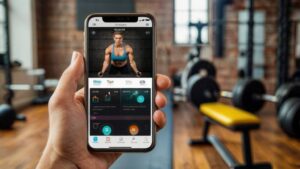How to Develop a Health App in 2024

In today’s digital age, health apps have become an integral part of our lives. These apps help individuals track their physical activity, monitor their vital signs, and provide personalized health recommendations. With the increasing importance of healthcare and wellness, developing a health app in 2024 can be a lucrative endeavor. This article will guide you through the process of creating a successful health app, covering everything from understanding the target audience to marketing the app effectively.
What is a Health App?
Before diving into the nitty-gritty of developing a health app, let’s first understand what it actually is. A health app is a software application designed to promote healthy living, provide medical information, and assist users in managing their well-being. These apps can be installed on smartphones, tablets, or wearable devices. Examples of popular health apps include Fitbit, MyFitnessPal, and Headspace. Fitbit helps users track their physical activity, sleep patterns, and heart rate. MyFitnessPal helps users monitor their diet and calorie intake. Headspace offers guided meditation and mindfulness exercises.
The Importance of Health Apps
Understanding the significance of health apps is crucial for any developer. These apps offer many benefits that contribute to individuals’ overall well-being.
Some key benefits of health apps include:
Monitoring and managing health: Health apps enable users to keep track of their physical activity, sleep patterns, calorie intake, and other vital signs. This data can help individuals make informed decisions regarding their health and lifestyle choices.
Access to medical information: Health apps provide users with access to a vast amount of medical information, ranging from symptom checkers to medication reminders. This empowers individuals to take control of their health and make educated decisions.
Personalized recommendations: Health apps utilize data and algorithms to provide customized health recommendations. This personalized approach ensures that users receive advice tailored to their specific needs and goals.
The rising demand for health apps is fueled by the increasing awareness and interest in personal well-being. People are becoming more proactive about their health and seeking convenient ways to manage it. As a result, the demand for health apps is expected to soar in the coming years.
The Basics of Developing a Health App
Before delving into the development process, it is essential to have a clear understanding of the basics of developing a health app.
Understanding the Target Audience
Identifying your target audience is crucial for the success of your health app. Different demographic groups may have specific needs and preferences when it comes to health and wellness. Conduct market research to gain insights into your potential users’ requirements, demographics, and behaviors. This information will guide your decision-making process throughout the development process.
Determining the Core Features
Once you have identified your target audience, it is time to determine the core features of your health app. This involves brainstorming and deciding on the functionalities that will appeal to your users and provide value. For example, if your target audience consists of fitness enthusiasts, features like activity tracking, workout plans, and meal logging would be essential.
Deciding on the Development Platform
Choosing the right development platform is crucial for the success of your health app. Consider factors such as user base, cost, scalability, and ease of maintenance when deciding between iOS, Android, or cross-platform development. Each platform has its own advantages and limitations, so weigh your options carefully before making a decision.
Key Considerations for Health App Development
When developing a health app, there are several key considerations that need to be taken into account to ensure its success.
1. Compliance with Regulatory Guidelines
Health apps deal with sensitive user data, so it is vital to prioritize data privacy and security. Ensure that your app complies with regulatory guidelines such as the General Data Protection Regulation (GDPR) and the Health Insurance Portability and Accountability Act (HIPAA). Implement robust security measures to protect user data from unauthorized access.
Adhering to healthcare industry standards is also crucial for the credibility and reliability of your health app. Collaborate with healthcare professionals and subject matter experts to ensure that your app aligns with best practices in the industry.
2. User-friendly Interface and Design
The user interface (UI) plays a significant role in the success of a health app. Users should find the app easy to navigate and visually appealing. Incorporate intuitive navigation and a well-organized layout to enhance the user experience. Utilize engaging visuals and colors that align with your app’s branding to create a visually pleasing interface.
3. Integration of Health Monitoring Functionalities
One of the key features of health apps is their ability to integrate with wearables and sensors. Allow users to connect their devices, such as fitness trackers or smartwatches, to your app. This enables real-time tracking of health data and provides valuable insights to users. Implement functionalities for tracking and analyzing data such as step count, heart rate, sleep patterns, and calories burned.
4. Incorporating Personalized Features
Personalization is the key to attracting and retaining users. Implement features that allow users to create customized profiles and input relevant information such as age, weight, and medical history. Leverage this data to provide tailored recommendations and personalized insights. For example, a user with diabetes could receive personalized diet and exercise suggestions to manage their condition effectively.
5. Implementing AI and Machine Learning Capabilities
AI and machine learning have revolutionized the healthcare industry. Incorporate these capabilities into your health app to enhance user experience and provide advanced functionalities. Intelligent symptom analysis can help users determine potential health issues based on their symptoms. Predictive health insights can alert users to potential risks or encourage proactive measures for maintaining good health.
The Development Process
Now that you have a clear understanding of the key considerations, it’s time to delve into the development process of a health app.
1. Conduct Market Research
Before diving into development, conduct thorough market research. Identify your competitors and analyze their strengths and weaknesses. This will help you differentiate your app and identify unique selling points. Additionally, gather user feedback to understand what they expect from a health app and how you can meet those expectations.
2. Create Wireframes and Prototypes
Visualize the layout and flow of your app by creating wireframes and prototypes. This will help you map the user journey and ensure a seamless user experience. Test user interactions and gather feedback to refine your app’s usability and design.
3. Backend Development and API Integration
Build a scalable and secure infrastructure for your health app’s backend. This involves setting up databases, servers, and implementing cloud services. API integration is vital for connecting your app with external healthcare databases and services. Ensure that data transfer is secure and efficient.
4. Frontend Development and User Interface Design
Develop an appealing and responsive design for the front end of your app. This involves coding the user interface and implementing the visual elements. Follow best practices for responsiveness to ensure that your app works well on different devices and screen sizes. Test your design extensively to ensure a smooth user experience.
5. Testing and Bug Fixing
Thoroughly test your app to identify and fix any bugs or issues. Perform rigorous quality assurance to ensure that your app functions as intended and meets user expectations. Address any user-reported issues promptly to maintain a positive user experience.
6. Deployment and Ongoing Maintenance
Choose an appropriate app store to deploy your health app. Consider factors such as user base, visibility, and ease of distribution. Regularly update your app with bug fixes and new features to keep users engaged and satisfied.
Marketing and Promotion of the Health App
Once you have developed your health app, it’s time to focus on marketing and promotion.
Here are some strategies to consider:
1. Develop a Compelling App Description
Craft a compelling app description that highlights the unique features and benefits of your health app. Clearly communicate how your app can improve users’ well-being or simplify their healthcare routines. Utilize persuasive language to convince potential users to download and try your app.
2. App Store Optimization (ASO)
Optimize your app’s visibility and discoverability on app stores through App Store Optimization (ASO). Use relevant keywords in your app’s title, description, and tags to improve its search ranking. Pay attention to app icons and screenshots, ensuring they accurately represent your app’s features and entice users to learn more.
3. Social Media and Influencer Marketing
Utilize social media platforms to create engaging content around your health app. Share health tips, success stories, and updates to keep users informed and engaged. Collaborate with relevant influencers in the health and wellness niche to reach a wider audience and gain credibility.
4. User Reviews and Ratings
Positive user reviews and ratings play a significant role in attracting new users and building trust. Encourage your users to leave positive feedback by offering incentives or asking them to share their experiences on social media. Promptly address any negative feedback or concerns raised by users to demonstrate your commitment to their satisfaction.
Future Trends in Health App Development
As technology continues to advance, the future of health app development looks promising.
Here are some trends to watch out for:
Telemedicine Integration: The integration of telemedicine services within health apps will allow users to consult with healthcare professionals remotely, providing convenience and accessibility.
AI-Powered Virtual Assistants: AI-powered virtual assistants will become more advanced, providing personalized health and wellness recommendations based on individual preferences and goals.
Advanced Data Analytics: Utilizing big data and advanced analytics will enable health apps to provide accurate predictive insights and personalized recommendations.
Gamification: Gamification techniques will be used to make health apps more engaging and motivate users to achieve their health goals.
Conclusion
Developing a health app in 2024 can be a rewarding venture, given the increasing demand for digital health solutions. By understanding the core features, considering key development factors, and implementing effective marketing strategies, you can create a successful and impactful health app. Remember to prioritize the needs of your target audience, adhere to regulatory guidelines, and focus on providing a seamless user experience. With careful planning and execution, your health app has the potential to revolutionize the way individuals manage their health and well-being. So, get ready to take the plunge into the exciting world of health app development!
https://7thavewellnessblog.com/?p=77
https://appinventiv.com/
FAQ’s
Q: What is a healthcare app?
A: A healthcare app is a mobile application designed to provide various medical and health-related services, including tracking health data, connecting with healthcare providers, scheduling appointments, accessing medical information, and more.
Q: How much does it cost to build a healthcare app?
A: The cost of developing a healthcare app can vary significantly based on the complexity of the app, features included, development team rates, and other factors. A simple healthcare app may cost around $30,000 to $100,000, while more complex apps with advanced features can cost upwards of $300,000.
Q: What are the types of healthcare apps?
A: Healthcare apps can be categorized into various types, including medical record apps, telemedicine apps, medication management apps, health and fitness tracking apps, appointment scheduling apps, and more.
Q: What is the difference between a health app and a medical app?
A: The primary difference lies in the focus and functionality. Health apps are generally focused on fitness, wellness, and lifestyle management, while medical apps are more tailored towards medical diagnosis, treatment management, and connecting with healthcare providers.
Q: How do I choose a healthcare app development team?
A: When choosing a healthcare app development team, consider their experience in healthcare app development, expertise in compliance with healthcare regulations, portfolio of successful healthcare apps, ability to integrate security features and understanding of user experience in healthcare applications.








